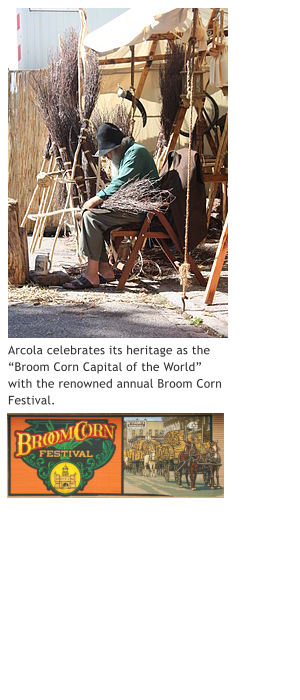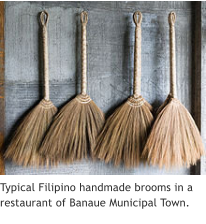
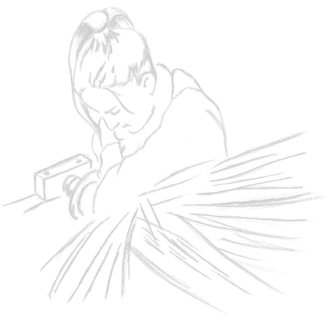
History and information on brooms
Broom Brooms have been used for centuries to sweep up, in, and around the home and workplace. They may be made from a variety of materials, both man-made and natural. Man-made bristles are generally of extruded plastic and metal handles. Natural-material brooms may be constructed of a variety of materials, including brush, but generally include stiff grasses such as broomcorn and/or sotol fiber. Broomcom brooms have been made for at least 200 years and are considered superior brooms. Plastic brooms merely move dirt around, however, broomcom stalks actually absorb dirt and dust, wear extremely well, and are moisture-resistant. Broomcom brooms are the most expensive of the manufactured brooms. Broomcom is actually a variety of upright grass of the species sorghum referred to as Sorghum vulgare, or S. bicolor variety technicum, belonging to the family Gramineae and cultivated for its stiff stems. Broom bristles are derived when these stiff, tasseled branches—that bear seeds on the ends—are harvested and dried. The seeds are edible, starchy, and high in carbohydrates. They can be used for human consumption (in cereals) or for animal feed. The tasseled stalks, used in the manufacture of brooms, can grow 2-8 ft (0.61-2.4 m) tall. Sorghum is especially valued in hot and arid climates due to its resistance to drought. Mexico grows and processes most of the broomcom and sotol fiber used in American broom production. Sotol fiber, a yucca fiber, is sometimes used on the inside of the broom and is wrapped with more expensive broomcom, thus lowering the price of the natural-bristle broom. The production of broomcom brooms is still largely a craft production with a single operator working quickly at a machine, making brooms by hand. There have been some changes in the manufacture of broomcom brooms within the last several decades, but those changes have been very minor. Essentially, the handcraft has changed little since mid-twentieth century. Brooms were often used in matrimony rituals to symbolize a union.. Enslaved African-Americans married one another in a civil ceremony referred to as "jumping the broom" in which the couple would literally jump over a broom to signify matrimony. Today, African-Americans occasionally recreate this custom by jumping over a broom at weddings, using specially handmade and decorated brooms for this purpose. These brooms then become a centerpiece within the new household. History Ashes and dirt were moved around and out of the house using bundled branches and brush for centuries. Native grasses were dried and bundled together, often decoratively woven at the top or tied tightly with yarn or fabric to keep the brooms together. Southerners have used native sweet grass and other grasses for their long stalks with tasseled ends for broom bristle. The course of American broom history was altered in the late eighteenth century, when some say that in 1797 Levi Dickenson, a farmer from Hadley, Massachusetts, used a bundle of tasseled sorghum grass (also called broomcom) to make a broom for his wife. It is likely these early broomcom brooms were simply lashed or woven together, resulting in the fact that they often fell apart. Other experiments The word "broom" derives from the name of certain thorny shrubs (Genista and others) used for sweeping. The name of the shrubs began to be used for the household implement in Late Middle English and gradually replaced the earlier besom during the Early Modern English period. The song Buy Broom Buzzems (by William Purvis 1752 - 1832) still refers to the "broom besom" as one type of besom (i.e. "a besom made from broom") Flat brooms, made of broom corn, were invented by Shakers in the 19th century. A smaller whisk broom or brush is sometimes called a duster. One source states that the United States had 303 broom factories by 1839 and that the number peaked at 1,039 in 1919. Most of these were in the Eastern U. S. During the Great Depression, the number of factories declined to 320 in 1939.[4] Oklahoma became a major center for broom production because broom corn grew especially well there. The Oklahoma Broom Corn Company opened a factory in El Reno, Oklahoma in 1906, a year before statehood. Faced with competition from imported brooms and synthetic bristles, most of the factories closed by the 1960s.[4] Today, brooms are also commonly made with synthetic bristles. Another common type is the push/pull broom, consisting of a wide brush with short bristles, to which a broomstick is attached at an angle in the center of the brush. Whether Levi Dickenson was the first American to use sorghum to make brooms is in contention. However, nearly all acknowledge that the United Society of Believers, familiarly called the Shakers, quickly moved into the broom-making business about 1798 by growing broomcom and making brooms. The Shakers' Watervliet, New York, community took the lead in manufacturing brooms, although nearly all the Shaker communities constructed and sold them throughout the century. The Shakers are credited with inventing the flat broom. They recorded that Theodore Bates of Watervliet examined the circular bundled broom and determined that flat brooms would move dust and dirt more efficiently. The bundles were put into a vice, flattened, and sewn in place. The Shakers led the way in improving the broomcom broom. They appear to be the first to find that wire more effectively secured the broomcom to the wooden handle rather than tying or weaving. They developed treadle machinery to wind broomcorn around the handle while securing it tightly. They developed special vices to flatten the broom for sewing into the requisite flat shape. Still other machinery was devised to quickly separate the seeds of the broomcom from the tassel bristles. Using foot-powered machinery, the Shakers could make two dozen brooms per person per day—quite a feat for the early nineteenth century. Today, the machinery is electrically powered. However, in even the largest American broom factory, the production of broomcom brooms is still remarkably a hand craft. (One factory foreman in a large broomcom factory says he can pick up a broom and tell who amongst his staff made it because each one is made according to the skills and preferences of the maker.) A single machine and operator sits at a machine and constructs a broom. The machines, and the methods, have not changed in over 40 years. The most significant development in the history of the product resulted from the North American Free Trade Agreement (NAFTA) in 1994 when tariffs were lifted from broom-corn brooms imported from Mexico. Cheaper than American brooms (labor is cheaper and broomcorn is grown there in huge quantities), the Mexican-made broom importation obliterated many American broomcom manufacturers. American broomcom manufacturers pressed for more restrictive tariffs, but such tariffs were overruled. Today, there are only about 15 broomcorn manufacturers left in the United States. Raw Materials The material used is broomcom, which is shipped bundled in large bales. The bundles are grouped according to the length of the grass and color. Sotol fiber from the yucca plant may be used in cheaper broom-corn brooms. White metal wire, of approximately 18 gauge, is used to secure the broomcom and sotol to the handle. A small nail or two is used to secure the wire to the handle. The handles are generally of wood. Sometimes American hardwood is used, but more likely the wood used is ramin wood, an imported wood of dense, heavy, coarse grain. Thick twine is used to sew the brooms flat using a sewing machine. Finally, water is necessary in that the broomcom must be wetted completely in order to be worked. The Manufacturing Process It is important to note that brooms made from broomcorn are made at a station, using a single piece of machinery. Using this machine, brooms are largely still assembled by hand. The process described below is used by the largest manufacturer of brooms and the factory uses about 28 makers to produce 6,000 brooms per day. 1. The raw material for the broom, the broomcorn, comes into the factory already processed and bundled. The bundles are sorted by length and are sorted by the color of the fiber. Bundles are grouped together in a bale weighing about 120 lb (54 kg). Broomcom must be wet in order to be worked effectively and must be quickly dunked in water before being delivered to the operator. Each bale is lifted with a crane and submerged in a tank of water for 10 seconds. The bundles are then removed from the water using the crane. 2. Workers break apart the wet bales and separate the smaller bundles within the bales. The bundles are placed on racks and rolled to operators who sit at broom-manufacturing equipment. 3. An operator sits at a broom-making machine and has the broomcom and solid handles there to work. An individual handle is picked up by the operator. The operator inserts a metal wire into a hole drilled near the bottom of the handle. Then, the insides are first applied to the broom. In this process, the lowest- grade grass is pressed around the wooden handle, forming the center of the broom. This thick bundle of grass is secured tightly to the handle using the wire attached to the handle through the hole. 4. Then, the shoulders and sides of the broom are given shape as smaller bundles of lesser grade grasses are placed along each side of the center bundle of grass. This side corn is secured to the central bundle of grass using more tinned wire that is wrapped by hand tightly around the side corn as well as the central body of grass. 5. Next, the grass is cut off in a straight line just above the wire by the operator using a knife. 6. Over this foundation of lower-grade dbroomcom or other grasses is now added the outside of the broom, or the broomcom we see when we look at a broom. The hurl, the best grade of broomcom used in a broom, is attached to the broom. It is laid atop the center section and shoulders, completely covering it. The hurl is physically attached to the broom using the same piece of white metal wire used earlier in the process. 7. The final construction step is referred to as the run down. The operator runs the wire that secures the hurl down to the handle and nails it off, thus securing the cut end to the wooden handle. The grasses and broom-corn are now completely secured to the broom. 8. The brooms are now constructed but are not finished yet. In order to complete the broom, the broomcom must be dried out completely. The brooms are moved by rack or palette into a very large drying room that is thermostatically controlled. Depending on the weather, the brooms are left in this large, hot room for five to six hours. When instruments inside the room indicate that no more moisture is being released from the brooms, the heat kicks off and the broomcom has completely dried. 9. The brooms are now seeded, meaning that cylinders roll vertically over the broomcom, thus removing all the seeds and small pieces of broomcorn not secured to the handle that will fall out quickly upon use. 10. The seeded brooms are taken to sewing machine operators who run the brooms through a heavy-duty sewing machine with two needles that is threaded with thick twine. The brooms are put through the machine and the broom is flattened and its shape is maintained through the double, triple, or quadruple rows of sewing (depending on the machine and company) that holds the grasses tightly. It takes about 45 seconds to sew the brooms into a flat shape. 11. The brooms are moved by cart to final finishing, where they are trimmed across the bottom so they are even, packaged, and sent for distribution. Quality Control Broomcom is carefully graded so that the manufacturer understands the quality of the product that is shipped in the bale. Broomcorn is categorized by length and by color, with the brown-red broomcorn considered inferior. Inferior broomcom may be used on the inside of the broom close to the handle and the operator ensures that the inferior product remains out of sight. Machinery must be in good shape as well. Each individual broom-making machine is maintained, and the craftsman at each machine knows instantly when the machine is amiss. Other machinery such as the hydrostatic dryers or the seed removers are carefully monitored to ensure they perform efficiently. However, it is the broom makers themselves who are the key to monitoring quality of broomcorn brooms. Because the manufacture is completed using one operator per station who works from beginning to end on the product, he or she is sees and handles the product for nearly the entire process (except the sewing process). Each operator can tell whether the product has gone awry and can set aside such a broom so that it will not make it to a retail outlet. Byproducts/Waste There is little waste as the processing of the broomcorn and sotol occurs in Mexico. However, there are still seeds to remove and the shorter grasses captured within a bundle of grass is hauled away immediately. These grasses and seeds can be a fire hazard and do not stay long in the factory. (Broomcom is a bit difficult to catch afire but once it begins burning it is difficult to stop.) The Future The broom model has changed little over the past 200 years. Today, there are brooms with synthetic fibers that attract dirt and dust. There are also brooms made of finer, polypropylene fibers with angled bristles. Smaller whisk brooms are also available as are brooms with easy to grip rubber handles. The Internet has brought broomcorn brooms to every home with easy ordering and delivery. Brooms in wider culture "Big Sweep", sculpture at Denver Art Museum, ColoradoIn the Gospel of Luke 15:8 "The Parable of the Lost Coin", the broom is mentioned: "Suppose a woman has ten silver coins and loses one. Does she not light a lamp, sweep the house and search carefully until she finds it?" The first known reference to witches flying on broomsticks dates to 1453, confessed by the male witch Guillaume Edelin. The concept of a flying ointment used by witches appears at about the same time, recorded in 1456. Poets use the broom in metaphor making. In one of Emily Dickinson's poems Mother Nature, Nature ". . .sweeps with many colored brooms, and leaves the shreds behind. . ." The Métis people of Canada have a broom dancing tradition. There are broom dancing exhibitions where people show off their broom dancing skills. The lively broom dance involves fast footwork and jumping. In Jainism, monks and nuns have a little broom with them, in order to gently brush aside ants and small animals, to avoid crushing them. This is an act of non-violence to the small animals. An African American wedding tradition incorporates the use of the broom. The custom is called "jumping the broom". The custom originates in marriages of slaves in the United States in the 19th century, but its revived popularity among African Americans is due to the 1976 novel Roots: The Saga of an American Family. During World War II, American submarine crews would hoist a broom onto their boat's fore-truck when returning to port to indicate that they had "swept" the seas clean of enemy shipping. The tradition has been devalued in recent years by submarine crews who fly a broom simply when returning from their boat's shake-down cruise. This tradition no doubt stems from the action of the Dutch admiral Maarten Tromp who tied a broom to his main mast after defeating the British admiral Robert Blake at the Battle of Dungeness in 1652. This has often been interpreted as a message that he would "sweep the British from the seas". This story remains unsubstantiated, but may have its origin in the tradition of hoisting a broom as a sign that a ship was for sale, which seems more likely as Tromp had captured two of Blake's ships in the battle. in sports Curling broom In baseball, when the home team is close to accomplishing a sweep (having won the first two games of a three-game series or first three games of a four- game series), some fans will bring brooms to the ballpark and brandish them as a way of taunting the visiting team. (Examples: Arkansas vs LSU- 2011; Red Sox v. Yankees—May 13–15, 2011 and June 7–9, 2011) In broomball, broomsticks have their heads removed and are used to push a ball into a goal, on an ice surface. The game is similar to hockey, except players do not wear skates. Magic In the context of witchcraft, broomstick is likely to refer to the broom as a whole, known as a Besom. In The Wizard of Oz, the Wicked Witch of the West used a broomstick to fly over Oz. She also used it to skywrite "Surrender Dorothy" above the Emerald City. The Wizard commands Dorothy and her three traveling companions to bring the Wicked Witch's broomstick to him in order to grant their wishes. Dorothy carries it to the Wizard with the Scarecrow, Tin Man, and Lion after the Wicked Witch's death. In the movie Fantasia, Mickey Mouse, playing The Sorcerer's Apprentice, brings a broom to life to do his chore of filling a well full of water. The boom overdoes its job and when chopped into pieces, each splinter becomes a new broom that flood the room until Yen Sid stops them. This story comes from a poem by Goethe called "Der Zauberlehrling" ("The Sorcerer's Apprentice"). The Disney brooms have had recurring cameos in Disney media, mostly portrayed as janitors, albeit not out of control or causing chaos such as in the original appearance. In the movie Harry Potter and the Sorcerer's Stone (film), There is a Wizarding Game called Quidditch where players use their broomsticks to fly around a field and shoot goals. Harry Potter (character) plays the game also. Broomsticks are also a form of transport which wizards and witches use. In Swaziland, witches broomsticks are short bundles of sticks tied together without a handle.
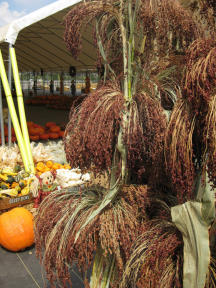
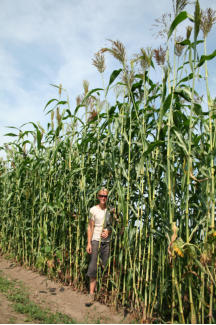
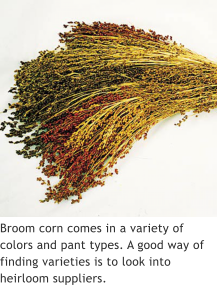


Clamp used to hold and press the
brooms while the craftsman stitches
the bristles.
